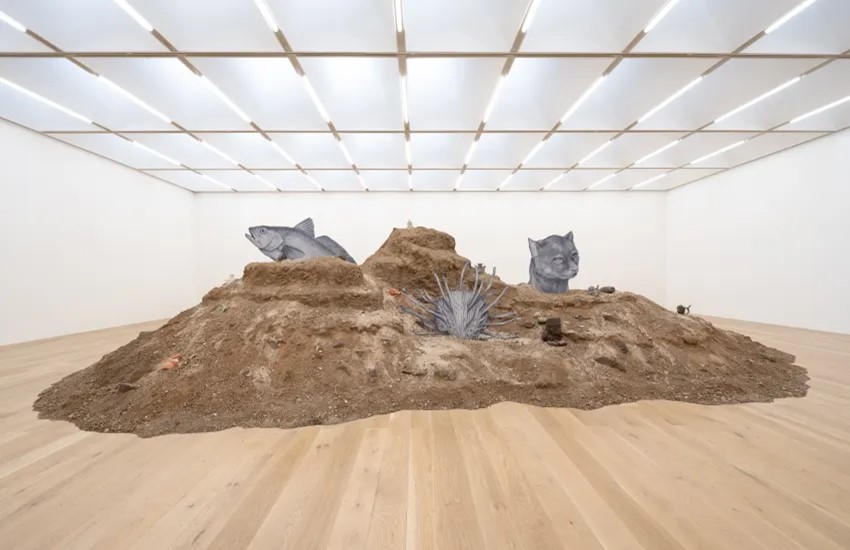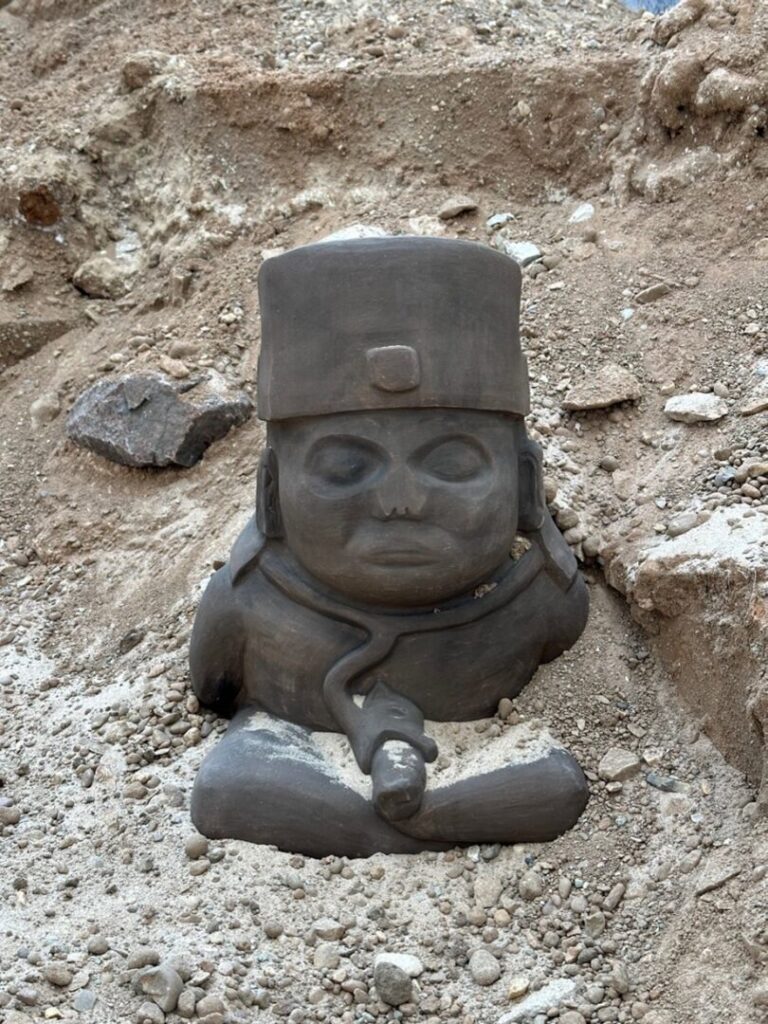A mountain of soil, ceramics and huge black-and-white aluminium prints dauntingly welcomes the viewer at Nottingham Contemporary. The newly commissioned installation by Claudia Martínez Garay entitled “WAKCHAKUNA / We Who Share Everything and Nothing” is built at the centre of an otherwise common white cube exhibition room with natural light coming from the ceiling. The mountain itself invites the viewer to discover its treasures, but also intimidates. Once visitors let their curiosity take over and walk around, the large prints are discovered to be fragmented, just like the ceramic objects partly visible and partly hidden in the soil.
These ceramic objects are referred to as wakchas, which means orphaned, or removed from their original context and intended purpose. These are the central artworks of the whole exhibition, and these small replicas represent vessels and fragments of the Inca and Moche Peruvian civilizations, today very often found in European museums. These objects have been made orphaned and exiled from their land, and metaphorically imprisoned within nearly forgotten collections in Europe, where they are not always understood for their cultural and historic importance.

The mountain is envisaged as a sacred safe space for these objects, as a place of belonging, where they are guarded by non-human creatures, here represented through the giant prints: an otter, a cojinova fish, a spondylus shell and a wild jaguarundi cat.
Garay (b. 1983 in Ayaucho, Perù) researches in her practice pre-Columbian knowledge systems, and is particularly interested in the ways in which artefacts, cultural relics and propaganda shape the history and social-political memory of cultures. Her work aims at challenging the persistence of colonialist frameworks and official narratives informing our understanding of pre-Columbian cultures, and focuses on stories and identities that have been obscured through literal and metaphorical erosion.

In this new work by Garay, there is a clear shift from the conception of the prisoner to that of the orphan. This transformation moves from a memorial to prisoners of war and political partisanship to a reflection on people trapped in their own countries, and objects trapped inside foreign museum collections. The ceramic figures prompt us to consider the plight of displaced individuals in connection to the repatriation of cultural objects.
The figure of the orphan, in addition, symbolises someone who has been displaced from their homeland, and Garay’s exhibition advocates for the return of these objects to their place of origin, and provides them with a sacred resting place: this mountain.

An example of a widely misinterpreted series of objects is also presented in the installation: namely, piece 10 “Woman and Skeleton Pottery”. The vessel is made in the form of a skeleton and a woman embracing. The skeleton is gripping the woman’s bottom lip, while the woman is holding the skeleton penis. This ceramic vessel is part of a unique subset named “sex pots”, which depict human figures in a wide range of sex acts. Contemporary interpreters may assume that they were designed to be erotic if not pornographic. However, the presence of a skeleton aids in understanding the artwork’s meaning. Archaeologists have found these pots in high-society tombs, and suggest that these were not erotica. In pre-Columbian Andean religious life, ancestors were paramount: as skeletons do not have erect penises, the depiction of this organ symbolises fertility and therefore the power and legacies of ancestors.[1]
Reflecting on the exhibition and the discussions raised during the ‘Wednesday Walkthrough’ event held at Nottingham Contemporary on 7 August, two major themes stand out as urgently needing to be addressed: terminology and the role of artists in relation to institutions.
At the basis of both there is a major lack of interest and therefore of knowledge and representation of non-settler societies in the Americas and other colonised spaces. They are often referred to as indigenous or native, and in the geography of Peru, as Andeans, but there is a major problem inherent in the terminology.
The terms Aborigine, Indian, Indigenous, or First Nations are often offensive to tribal groups especially when used to universally label radically different groups. These terms homogenise peoples, echoing early imperial anthropology’s creation of the ‘other’ in opposition to colonial settlers. Historically, these labels have been derogatory, inaccurate, and rooted in colonial views of ‘primitive’ peoples. The word—from the Latin indigena, meaning “native” or “sprung from the land”—has been used in English since at least 1588. It originally applied not just to people but to flora and fauna as well, imparting the term with an air of wildness and detaching it from history and civilization. The racial connotation intensified during the colonial period, distinguishing white settlers—and, in many cases, their slaves—from the non-Europeans who occupied lands before them. The University of British Columbia’s (UBC) ‘Indigenous Foundations’ highlights the term’s increasing use due to international Indigenous rights movements. While ‘Indigenous’ is inclusive, identifying peoples across national boundaries, it is contentious because it defines groups primarily in relation to their colonisers. At other times, like in the case of ‘Maori’, the term was introduced to erase the diversity of New Zealand’s indigenous tribes. ‘Indigenous’ peoples often prefer to be identified by their specific nation or tribe names, which can also be contentious.[2] And a further point of reflection has to be made with regards to the limits that so-called ‘indigenous’ communities have to face to keep their identity and status, which often times comes into conflict with accessing services and might result in numerous language barriers. For example, in Perù the language of government and metropolitan life is Spanish. However, people living in the Andes and other regions far from cities speak mostly Quechua and this prevents them from accessing primary civic services. Nevertheless, the language itself is only kept alive by these communities that use and pass it on for generations.
In this complex situation, indigenous artists such as Garay often fill the gaps left by institutions, creating work that addresses their indigeneity and the issues surrounding repatriation and return. Garay has created the ceramic replicas working directly from European collections, that often held such a large number or artworks that are rarely exhibited and studied. In addition, the situation is critical in Perù where, on the one hand, unauthorised excavations and thefts continue to harm its heritage, and on the other hand ‘indigenous’ Andean objects and cultural heritage are not a priority for the modern Peruvian government when it comes to research and repatriation.
I would like to end this brief reflection with the words of Garay:
“Imagine how the ancient Peruvians would feel seeing our world today. Modernity has shamelessly disregarded their traditions and beliefs. Offerings and artefacts were stolen and stashed away in Europe, lost and robbed of their purpose. But just as the ancient cultures couldn’t foresee our present, Europe can’t conceive a future deprived of these artefacts.” – Claudia Martínez Garay, 2024
Now, every time I approach artworks from a different culture I question my assumptions and ideas, and I try to discover more about the people and places that produced them and how they want to be identified.
Written by Giorgia Maffioli Brigatti
This article was informed by the talk and subsequent discussions during the ‘Wednesday Walkthrough‘ event held at Nottingham Contemporary to highlight the exhibition “Claudia Martínez Garay: WAKCHAKUNA / We Who Share Everything and Nothing” (open until 8th September), in collaboration with Uncomfortable Cambridge. I would like to thank Olivia Durand (R&D), Katie Simpson (Curator) and Klara Szafranska (Assistant Curator) for their support.
Uncomfortable Cities regularly works with museums, galleries and other cultural organisations to run tours and specific events such as this one. If you are interested in commissioning us to help with an event you are planning, please contact us here to make initial enquiries. To learn more about the contested memorialisation of pre-Columbian societies and their colonial conquest, you can also read our article on the Diego de Landa memorial in Mexico.
References
[1] Stephen Nash, ‘Skeleton Sex Pots‘, Sapiens.org (31 March 2016).
[2] John Rangihau, ‘Being Māori’ in M. King, ed., Te Ao Hurihuri: Aspects of
Māoritanga (Octopus Publishing Group 1992).





